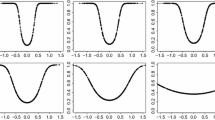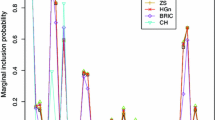Abstract
Model selection problems involving nonnested models are considered. Bayes factor based solution to these problems needs prior distributions for the parameters in the alternative models. When the prior information on these parameters is vague default priors are available but, unfortunately, these priors are usually imporper which yields a calibration problem that makes the Bayes factor to be defined up to a multiplicative constant. Intrinsic priors have been introduced for solving this difficulty. While these priors are well established for nested models, their construction for nonnested models is still an open problem.
In this latter setting this paper studies the system of functional equations that defines the intrinsic priors. It is shown that the solutions to these equations are obtained from the solutions to a single homogeneous linear functional equation. The Bayes factors associated with these solutions are analyzed. Some illustrative examples are provided and, in particular, location, scale, and location-scale models are considered.
Similar content being viewed by others
References
Berger, J. O. andDelampady, M. (1987). Testing precise hypotheses.Statistical Science, 3:317–352.
Berger, J. O. andPericchi, L. R. (1996). The intrinsic Bayes factor for model selection and prediction.Journal of the American Statistical Association, 91:109–122.
Berger, J. O. andSellke, T. (1987). Testing a point null hypothesis: the irreconcilability ofp-values and evidence.Journal of the American Statistical Association, 82:112–122.
Cox, D. R. (1985). Test of separate families of hypotheses. InFourth Berkeley Symposium, vol. 1, pp. 105–123.
Dmochowsky, J. (1994). Intrinsic priors via Kullback-Leiber geometry. In J. M. Bernardo, J. O. Berger, P. Dawid, and A. F. M. Smith, eds.Bayesian Statistics, vol. 5, pp. 543–549. Oxford University Press.
Edwards, L., W., H. andSavage, L. J. (1963). Bayesian statistical inference for psychological research.Psychological Review, 70:193–242.
Girón, F. J., Martínez, M. L. andMoreno, E. (2003). Bayesian analysis of mafched pairs.Psychological Review, 113:49–66.
Huber, P. (1967). The behavior of maximum likelihood estimators under nonstandard conditions. InFourth Berkeley Symposium, vol. 1, pp. 221–233.
Jeffreys, H. (1961).Theory of Probability. Oxford University Press, London.
Kass, R. E. andRaftery, A. (1995). Bayes factors.Journal of the American Statistical Association, 90:773–795.
Kass, R. E. andWasserman, L. (1995). A reference Bayesian test for nested hypotheses and its relationship to the schwarz criterion.Journal of the American Statistical Association, 90:928–934.
Kuczma, M., Choczewski, B., andGer, R. (1990).Iterative functional equations. Cambridge University Press.
Moreno, E. (1997). Bayes facor for intrinsic and fractional priors in nested models: Bayesian robustness. In D. Yadolah and C. Hayward, eds.,L1-Statistical Procedures and Related Topics, vol. 29, pp. 257–270. Institute of Mathematical Statistics.
Moreno, E., Bertolino, F., andRacugno, W. (1998). An intrinsic limiting procedure for model selection and hypotheses testing.Journal of the American Statistical Association, 93:1451–1460
Moreno, E., Bertolino, F. andRacugno, W. (1999). Default Bayesian analysis of the Behrens-Fisher problems.Journal of Statistical Planning and Inference, 81:323–333.
Moreno, E., Bertolino, F. andRacugno, W. (2000). Bayesian model selection approach to analysis of variance under heteroscedasticity.The Statistician, 49:503–517.
Moreno, E. andCano, J. A. (1989). Testing a point null hypothesis: Asymptotic robust Bayesian analysis with respects to the priors given in a subsigma field.International Statistical Review, 57:221–232.
Moreno, E. andLiseo, B. (2003). Default priors for testing the number of components of a mixture.Journal of Statistical Planning and Inference, 111:129–142.
Moreno, E., Torres, F., andCasella, G. (2002). Testing equality of regression coefficients in heteroscedastic normal regression models. Tech. rep., Department of Statistics University of Granada.
O'Hagan, A. (1994).Kendall's advanced theory of statistics, vol. 2B ofKendall's Library of Statistics. Edward Arnold, London.
O'Hagan, A. (1995). Fractional Bayes factor for model comparison (with discussion).Journal of the Royal Statistical Society, 57:99–138.
Shen, X. andWasserman, L. (2001). Rates of convergence of posterior distributions.Annals of Statistics, 29:689–714.
Spiegelhalter, D. J. andSmith, A. F. M. (1982). Bayes factor for linear and log-linear models with vague prior information.Journal of the Royal Statistical Society, 44:377–387.
Author information
Authors and Affiliations
Corresponding author
Rights and permissions
About this article
Cite this article
Cano, J.A., Kessler, M. & Moreno, E. On intrinsic priors for nonnested models. Test 13, 445–463 (2004). https://doi.org/10.1007/BF02595781
Received:
Accepted:
Issue Date:
DOI: https://doi.org/10.1007/BF02595781




